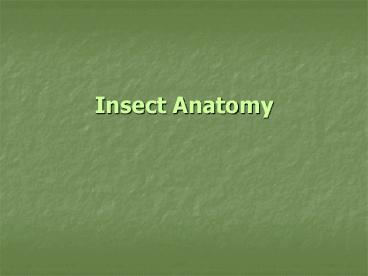Insect Anatomy PowerPoint PPT Presentation
1 / 48
Title: Insect Anatomy
1
Insect Anatomy
2
Classification
- Phylum
- Class
- Order
- Family
- Genus
- Species
3
Arthropods
- Spiders, ticks, lobster, centipedes, and insects,
among others - Insects are members of the Phylum Arthropoda
(jointed foot) - an estimated 1 Million species of insects exist,
of which lt0.1 are harmful to plants
4
Arthropods
- Why are Arthropods so successful?
- Adaptability
5
Arthropods
- Adaptability
- Specialized appendages
- Mole crickets, giant water bug, preying mantis
6
- http//www.foxnews.com/science/2013/09/14/creature
-with-interlocking-gears-on-legs/
7
Arthropods
- Adaptability
- Exoskeleton (Invertebrates)
- Proportional strength
- Protection
8
Body Sections
- HEAD - THORAX - ABDOMEN
9
Class Arachnida
- Spiders
- Well cover only one spider mites
- Head/thorax (cephalothorax)
- Four pairs of legs
- Abdomen
10
(No Transcript)
11
(No Transcript)
12
Classification
- Phylum
- Class Insecta
- Order
- Family
- Genus
- Species
13
Class Insecta
- EXOSKELETON
- Solid outer skeleton
- Accounts for shape and size
- Cuticle is outermost layer that conserves moisture
14
Class Insecta
- EXOSKELETON
- How does it grow?
- Molting chemical reactions make it flexible, it
grows, then hardens again (schlerotization) - Each molting called instar
- (Cicada hatching)
15
(No Transcript)
16
- http//uncovercalifornia.com/content/21191-researc
hers-create-cybernetic-moth
17
HEAD
- Antennae
- Sensory organs
- Food
18
HEAD
- Antennae
- Sensory organs
- Pheromones - communication chemicals secreted by
insects
19
HEAD
- Compound eyes (2)
- Numerous faucets that each have a lens, each
singly functional
20
HEAD
- Compound eyes (2)
- Senses color, movement, and, to a lesser extent,
distance
21
(No Transcript)
22
HEAD
- Simple eyes, Ocelli (1 to 3)
- Records daily changes in light intensity
23
HEAD
- Mouthparts Chewing
- Mandibles are often protective
24
HEAD
- Mouthparts Chewing
- Maxilla like appendages
25
(No Transcript)
26
HEAD
- Mouthparts
- Piercing sucking
27
THORAX
- Mid-section
- Pro-, meso-, and meta-
28
THORAX
- Each segment has a pair of legs
- Front pair are often greatly modified
29
THORAX
- Caterpillars have prolegs on abdomen
- Not true legs
30
THORAX
- Wings
- Meso- and meta-thorax sections
- SloMo
31
(No Transcript)
32
THORAX
- Wings Beetles
- Forewings hardened, elytra
- Protection of hind wings
33
THORAX
- Wings Grasshopper
- Forewings leathery
- Hindwings fly
34
THORAX
- Wings True bugs
- Forewings, basal portion hardened
- Hindwings, membranous
35
THORAX
- Wings Moths and butterflies
- Both wings scales
36
ABDOMEN
- Softest body section
- Spiracles, openings insect uses to breathe
37
ABDOMEN
- Few appendages
- Ovipositor
- Laying eggs or stinger
38
ABDOMEN
- Few appendages
- Cerci
- Can be sensory organ or protective
39
LIFE CYCLES
- Insects begin life as an Egg
- Some exceptions are live birth, such as Aphids
(Viviparous)
40
LIFE CYCLES
- Complete Metamorphosis
41
LIFE CYCLES
- Complete Metamorphosis
- Larva (immature stage)
- Damaging stage, feeding heavily on foliage or
roots - Major difference in shape and habit from adult
42
LIFE CYCLES
- Complete Metamorphosis
- Pupae
- Idle stage, transforming into adult
- Cocoon vs. chrysalis
43
LIFE CYCLES
- Complete Metamorphosis
- Adult (mature stage)
- Adults dont often cause major damage
44
LIFE CYCLES
- Incomplete Metamorphosis
45
LIFE CYCLES
- Incomplete Metamorphosis
- Nymph (immature stage)
- Differ from adult in size and shape
- Gradual changes
- Wings undeveloped
46
LIFE CYCLES
- Incomplete Metamorphosis
- Adult (mature stage)
- Wings develop
47
LIFE CYCLES
- Incomplete Metamorphosis
48
Microcosmos
- http//www.youtube.com/watch?v76R2EKEnoJQ

